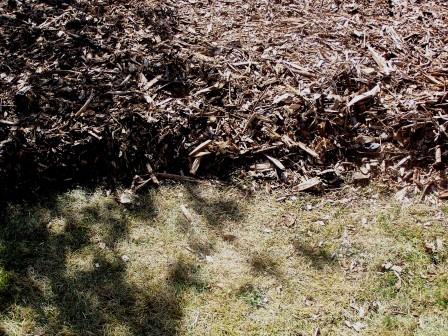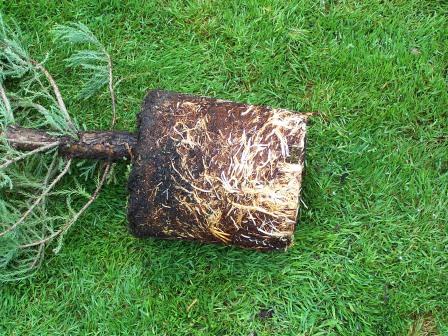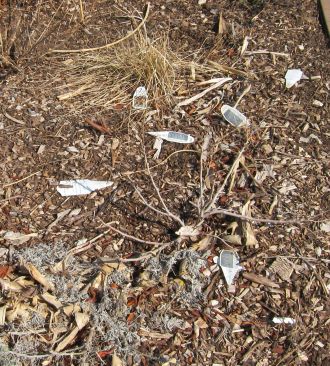Let’s see if anyone can figure out what this is:

What’s the plant, and what in the world has been done to it?
Answer Monday!
Yesterday I had the opportunity to listen to Marla Spivak, a very highly regarded bee scientist, talk about how bees defend themselves from disease. Very interesting stuff. I took a lot of information away from the talk, two bits of which I want to share with you.
The first is a vocabulary word — propolis – go ahead, google it (I don’t think too much inappropriate stuff will pop up) – it’s an antimicrobial “ointment” which bees create from stuff like the resins on tree buds.
The second is that the number of bee colonies is the US has been going down in the US since 1945 for a number of reasons. One of the most important of which is the fact that we like to kill flowers, such as dandelions and clover, which bees like, and then we plant crappy flowers – at least as far as the bees are concerned. The whole crappy flower thing isn’t something that I’d spent much time thinking about, so it was kind of an ah-ha moment for me.
Here’s how it works. People tend to like double flowers. Double flowers usually occur because the male parts of the flowers – the parts which normally contain pollen – instead develop into petals. It’s a mutation – very pretty – but it inhibits the flower from reproducing itself through seed and it certainly isn’t great for bees who rely on pollen for food. So when we plant our gardens we are removing plants that bees may love because we consider them weeds. Then we replace these flowers with what amounts to plastic fruit. My opinion – this is probably more significant to the lives of both honey bees and native bees than whether we plant natives or exotics.
So let your yard go wild! The bees will thank you.
This week I got a complimentary copy of Urban Farm, dedicated to “sustainable city living.” The cover story is Lasagna Giardino – follow this recipe for a lasagna garden that grows perfect plants – Italian or not.

This is not a new idea, but was popularized several years ago as a way of preparing soil for planting. The article relates the steps:
1) Prepare the ground by mowing the lawn
2) Dig up the first 12″ of soil (double digging)
3) Place a layer of “noodles” (paper and cardboard are popular) – the low nutrient material
4) Place a layer of “sauce” (the green material)
5) Repeat as often as you like and “let it cook”
I like the first step of this. But my second step would be:
2) Add a thick layer (12″) of arborist wood chips and “let it cook.”
Double digging the soil 12″ isn’t necessary: we do it because it’s hard work, and we think we need to put elbow grease into the project. Making layers of noodles and sauce isn’t necessary: we do it because appeals to us -lasagna is a tasty comfort food.
There’s a lot of damage that this “recipe” can cause. Double digging the soil 12″ destroys soils structure. Don’t do it. The layers of noodles and sauce (especially the sauce) can create an overload of plant nutrients. Furthermore, the “noodle” layers – the sheet mulches – impede water and air movement. They’re not needed to keep the grass from growing through. Wood chips do this just fine on their own. And don’t worry about that initial 12″ of chips. Within a few weeks it will settle to about 8″. Let it sit for several weeks. Then pull aside some of the chips and take a look. If the process is done, the grass and/or weeds will be dead and decomposing – a natural compost layer. You can then plant whatever you like. Reuse the chips somewhere else in your garden.

It doesn’t look like lasagna, but it’s a heck of a lot easier and more closely mimics a natural mulch layer than lasagna does.
We’re supposed to get an inch or two of snow tomorrow. It was 75 degrees last week. Typical schizophrenic spring weather. But spring was already in full bloom a few weeks ago in Dallas, Texas. Our group of Virginia Tech floriculture faculty and grad students visited for the National Floriculture Forum, a meeting of researchers and educators. It was organized by Texas A&M and hosted by the Dallas Arboretum, home of uber-horticulturist Jimmy Turner.
The Arb was right in the middle of their “Dallas Blooms” festival – they plant half a million spring bulbs each year for the most amazing show this side of Keukenhof. I’ve never been a huge tulip fan, but somehow came back with a gazillion photos. You just couldn’t help it. It’s a beautiful display garden; don’t miss it if in the area.

Imagine 60+ acres of this. My retinas were burning. But in a good way.

A cute Fosteriana-type tulip, oddly named ‘Zombie’.
Note the use of pecan hulls as mulch. Results in the biggest, fattest squirrels you’ve ever seen.

I’ve seen some interesting art in public gardens, but this is a new fave.
Probably there’s a deeper meaning behind it, but basically it’s a man and woman snogging in the tulips.

Big squirting toads, with list of safety rules on what one shouldn’t do to/with the toad.

Jimmy said the place would be crawling with brides and babies by afternoon, and he was right. That’s what he gets for creating such a photogenic garden. Couldn’t swing a fat squirrel without hitting one or the other.
Recently I posted that many of the “rules” that gardeners cling to so tightly regarding tree planting (i.e., dig the planting hole 3 times the width of the root ball, always amend the backfill with organic matter) are probably better considered ‘suggestions’ than rules. While these practices won’t hurt, there are much better ways to spend time and effort to ensure long-term survival when planting a tree. Here are the top four:
Irrigate. No matter how much time and effort goes into the ‘perfect’ planting hole; for most parts of the country, trees that are not irrigated after planting are doomed. Linda advocates watering in several small sips during the week; I still stick to the old school notion of one long soak per week. In the final analysis, logistics will probably dictate which approach you use. Either way, the key is to provide trees with water during the establishment year and even into the second year after planting, if possible.
Mulch. Organic matter placed properly on top of the planting hole will do more good than organic matter placed in the planting hole. Study after study demonstrates that mulch conserves soil moisture by reducing evaporation from the soil surface, controls weeds, and moderates soil temperature. Oh, and that business about wood-based mulches ‘tying up’ or ‘stealing’ nutrients from landscape plants? Maybe for bedding plants, but not for trees and shrubs. Our research and other studies indicate that, for the most part, the type of organic mulch makes little difference compared to not mulching at all. Hence, my motto “Mulch: Just do it.”

Proper planting depth. Width of the planting hole may not matter, but planting trees too deep is a recipe for disaster. Burying roots too deep reduces oxygen levels around the roots and starts a series of unfortunate events for the tree. Find the root collar flare and keep it visible.

Bad move. The contractor was going to install drain tile but decided not to at the last minute to save money. Ouch.
Right tree, right place. In my experience, the number one reason newly-planted trees fail in the first year is lack of watering and aftercare. After year one, improper tree selection takes the top spot. Here in the Upper Midwest, poor drainage and heavy soils take their toll year after year. Lack of water can usually be addressed, but once a tree is planted in a spot that is too wet for that species, it’s usually a long, slow, and agonizing decline. And it’s amazing how often people will ignore obvious red flags in selecting trees. Our Dept. of Transportation recently planted 25 eight-foot B&B eastern white pine, which are notoriously salt sensitive, about 30’ from I-96 at a rest area between Lansing and Detroit. Predictably, after one winter’s exposure to deicing salt spray all the trees were dead or wishing they were dead. Right tree, right place. This ain’t rocket science, folks.

Great debate on the identity of Friday’s mystery plant! Several of you guessed larch, and this particular one is contorted larch (Larix kaempferi ‘Diane’), a cultivar of Japanese larch:

(As an FYI to a side discussion in the comments, tamarack is the common name for American larch, Larix laricina.)
And the eagle eye award to those of you who saw that YES! WE FINALLY HAVE A SEARCH FUNCTION on the blog! It’s still being tweaked so that the results pages will be a little more sophisticated, but it works. Now you don’t have to sort through hundreds of posts to find that one of Holly’s on pee bales. Or Jeff’s on drunken slugs.
Over the last two weeks I’ve been dwelling on the information that people get about gardening from various sources. I’m not talking about really serious gardeners – I’m talking about the guy down the block who might grow six tomatoes, two cucumbers, and a head of lettuce. He’s got 6 trees on his property and he keeps his lawn nice, but not immaculate, by mowing weekly and fertilizing and applying herbicides once a year. Where is this guy getting his gardening information? Can we (and by we I mean scientists like the garden professors) do something more than we currently are to reach him so that he’s using up to date information?
A couple of days ago I walking into the place where I get my taxes done – I’ve had the same person doing my taxes for the last 14 years or so and I’ve become friendly with her – and, after we got the paperwork done she introduced me to the receptionist by saying that I speak and write books about gardening. The receptionist (who doubled as the cashier) wanted to know more so I said “You know Jerry Baker?” She said “yes, I have a bunch of his books and I just bought a set for my father.” I said “Oh…Well I’m the guy who tells you that most of Jerry’s remedies don’t work.
She didn’t seem particularly impressed with me (and the cost of filing my return was higher than usual – coincidence?)
Anyway, my question to you is, how do we reach people like that?
A few days ago I got a question from Cynthia about “potting up.” For those of you for whom this is an unknown phrase (and no, it’s not a euphemism for a certain herbal activity), it refers to the practice of moving plants into ever larger containers. She was wondering if there was any “real science” behind the practice – in other words, why not just start out with a larger container?

Hah! I needed no further encouragement and spent several days collecting and reading decades’ worth of research. And there is a LOT of research on this topic. As you might guess, it’s geared towards production nurseries and greenhouses. But the good part is that it’s been done on just about any kind of plant material you could want. Vegetables. Annuals. Perennials. Grasses. Shrubs. Native plants. Ornamental, fruit and forestry trees. Seeds, seedlings, cuttings, big plants, little plants. Ahhhhh…data!
Almost without exception, you get better growth on plants grown in larger containers, whether you’re measuring height, number of leaves, leaf area, stem diameter, shoot and root dry and fresh weights, whole plant dry and fresh weight,…you get the idea. This isn’t surprising, because with a larger root zone you can support more roots, which in turn support more above-ground growth.
The only parameters which tended to diverge for some species were flower and fruit production. Restricted roots can stimulate sexual reproduction in plants, possibly because poor growing conditions spur the plant to reproduce before it dies. Other drawbacks include increased probability of circling root systems, and higher ambient soil temperature, compared to plants in larger containers.

Smaller containers might be considered desirable when one is trying to limit above-ground growth – the “bonsai” effect. And they require less water than larger containers – which brings us to the bottom line, as far as production nurseries are concerned.
Larger containers take more space. And water. In at least one study, water costs were shown to be “prohibitive for larger container sizes.” Furthermore, smaller containers are preferred by production nurseries to “optimize production space.” Another economics-based study found that “the smaller of these was the more economical.”

But most of you probably aren’t interested in the economics of plant production – you want to know what’s best for your own container plants, whether they are houseplants or pots of herbs or punches of annual color on your patio. The science is clear: it’s best to pot up plants in small containers quickly into their final destination, rather than making several (pointless) intermediate transplants.
Doing this…

I must identify each and every Wave petunia!
leads to this…

and this…

Unfortunately, the second and third photo are from a college teaching and display garden. There are a lot of inexpensive yet more attractive ways to relate plant identification to your visitors.
We all do this, of course, to some extent in our home gardens. Walk around with weird plant in hand, dig hole, stick it in, say to self "I’ll come back and get that label to add to my (pick one) Excel garden database/bag of random tags/photographic memory."
Typically, most of mine end up on top of the washing machine from cleaning out pants pockets. Not exactly a good record-keeping system.
Tags as tombstones: during spring mulching, I’ll typically find a few half-buried, printed with, oh, Maybehardii maybenotus – Plant Delights Nursery $25. Said plant is nowhere to be seen. Dang.